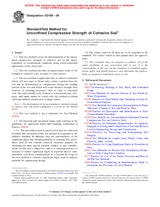Potřebujeme váš souhlas k využití jednotlivých dat, aby se vám mimo jiné mohly ukazovat informace týkající se vašich zájmů. Souhlas udělíte kliknutím na tlačítko „OK“.
ASTM D2166-06
Standard Test Method for Unconfined Compressive Strength of Cohesive Soil
Automaticky přeložený název:
Standardní zkušební metoda pro unconfined pevnosti v tlaku soudržné půdy
NORMA vydána dne 15.7.2006
Informace o normě:
Označení normy: ASTM D2166-06
Poznámka: NEPLATNÁ
Datum vydání normy: 15.7.2006
Kód zboží: NS-19489
Počet stran: 6
Přibližná hmotnost: 18 g (0.04 liber)
Země: Americká technická norma
Kategorie: Technické normy ASTM
Anotace textu normy ASTM D2166-06 :
Keywords:
cohesive soil, sensitivity, strain-controlled loading, strength, stress-strain relationships, unconfined compression, ICS Number Code 93.020 (Earth works. Excavations. Foundation construction. Underground works)
Doplňující informace
| Significance and Use | ||||||||||||||||||||||||||
|
The primary purpose of the unconfined compression test is to quickly obtain a measure of compressive strength for those soils that possess sufficient cohesion to permit testing in the unconfined state. Samples of soils having slickensided or fissured structure, samples of some types of loess, very soft clays, dry and crumbly soils and varved materials, or samples containing significant portions of silt or sand, or both (all of which usually exhibit cohesive properties), frequently display higher shear strengths when tested in accordance with Test Method D 2850. Also, unsaturated soils will usually exhibit different shear strengths when tested in accordance with Test Method D 2850. If tests on the same sample in both its intact and remolded states are performed, the sensitivity of the material can be determined. This method of determining sensitivity is suitable only for soils that can retain a stable specimen shape in the remolded state. Note 2—For soils that will not retain a stable shape, a vane shear test or Test Method D 2850 can be used to determine sensitivity. Note 3—The quality of the result produced by this standard is dependent on the competence of the personnel performing it, and the suitability of the equipment and facilities used. Agencies that meet the criteria of Practice D 3740 are generally considered capable of competent and objective testing/sampling/inspection. Users of this standard are cautioned that compliance with Practice D 3740 does not in itself ensure reliable results. Reliable results depend on many factors; Practice D 3740 provides a means of evaluating some of those factors. |
||||||||||||||||||||||||||
| 1. Scope | ||||||||||||||||||||||||||
|
1.1 This test method covers the determination of the unconfined compressive strength of cohesive soil in the intact, remolded, or reconstituted condition, using strain-controlled application of the axial load. 1.2 This test method provides an approximate value of the strength of cohesive soils in terms of total stresses. 1.3 This test method is applicable only to cohesive materials which will not expel or bleed water (water expelled from the soil due to deformation or compaction) during the loading portion of the test and which will retain intrinsic strength after removal of confining pressures, such as clays or cemented soils. Dry and crumbly soils, fissured or varved materials, silts, peats, and sands cannot be tested with this method to obtain valid unconfined compression strength values. Note 1The determination of the unconsolidated, undrained strength of cohesive soils with lateral confinement is covered by Test Method D 2850. 1.4 This test method is not a substitute for Test Method D 2850. 1.5 All observed and calculated values shall conform to the guidelines for significant digits and rounding established in Practice D 6026. 1.5.1 The procedures used to specify how data are collected/recorded and calculated in this test method are regarded as the industry standard. In addition, they are representative of the significant digits that should generally be retained. The procedures used do not consider material variation, purpose for obtaining the data, special purpose studies, or any considerations for the user's objectives; and it is common practice to increase or reduce significant digits of reported data to commensurate with these considerations. It is beyond the scope of this test method to consider significant digits used in analysis methods for engineering design. 1.6 The values stated in SI units are to be regarded as the standard. The values stated in inch-pound units are approximate. This standard does not purport to address all of the safety problems, if any, associated with its use. It is the responsibility of the user of this standard to establish appropriate safety and health practices and determine the applicability of regulatory limitations prior to use. |
||||||||||||||||||||||||||
| 2. Referenced Documents | ||||||||||||||||||||||||||
|
Doporučujeme:
Aktualizace zákonů
Chcete mít jistotu o platnosti užívaných předpisů?
Nabízíme Vám řešení, abyste mohli používat stále platné (aktuální) legislativní předpisy.
Chcete vědět více informací? Podívejte se na tuto stránku.




 Cookies
Cookies
